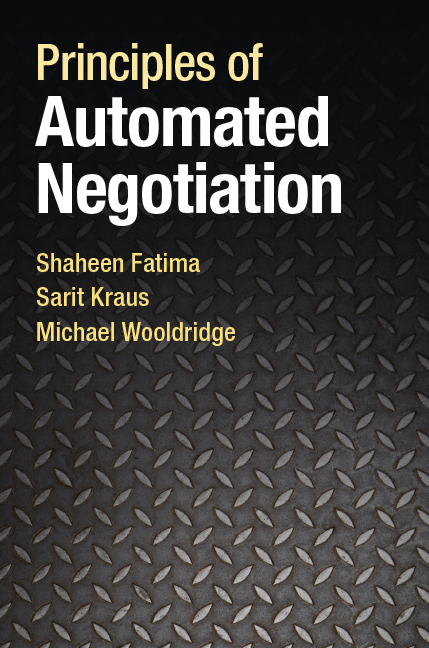
Principles of Automated Negotiation
by Shaheen Fatima, Sarit Kraus
, and Michael WooldridgeDATE OF PUBLICATION: November 2014
PUBLISHER: Cambridge University Press
ISBN: 9781107002548
Contents
List of illustrations
Preface
Summary of key notation
Chapter 1: Introduction
1.1 The Structure of Negotiation
1.2 Parameters of Automated Negotiation
1.3 A Strategic Approach
1.4 Desiderata for Automated Negotiation
1.5 Advantages and Disadvantages of Automated Negotiation
1.6 Structure of this Book
1.7 Historical Notes and Further Reading
Chapter 2: Games in Normal Form
2.1 Zero-sum and Non-zero-sum Games
2.2 Pure and Mixed Strategies
2.3 Rational Behaviour in Strategic Settings
2.4 Solution Concepts
2.5 Solution Properties
2.6 Social Measures of Utility
2.7 A First Glimpse of Bargaining as a Game
Chapter 3: Games in Extensive Form
3.1 A Formal Definition
3.2 Types of games and strategies
3.3 Nash Equilibrium
3.4 Subgame Perfect Nash Equilibrium
3.5 Beliefs and Sequential Rationality
3.6 Weak Perfect Bayesian Equilibrium
3.7 Sequential Equilibrium
3.8 The Role of Information
Chapter 4: Negotiation Domains
4.1 Classifying Negotiation Domains
4.2 Some Example Negotiation Domains
4.3 Historical Notes and Further Reading
Chapter 5: Strategic Analysis of Single-Issue Negotiation
5.1 The Negotiation Model
5.2 An Infinite Horizon Alternating Offers Protocol
5.3 A Finite Horizon Alternating Offers Protocol
5.4 Negotiation with Imperfect Information
5.5 Indivisible Issue Negotiation
5.6 Negotiating an Issue with Discrete Values
5.7 More on Negotiation Protocols
5.8 Historical Notes and Further Reading
Chapter 6: Strategic Analysis of Multi-issue Negotiation
6.1 Negotiation Procedures
6.2 The Negotiation Model
6.3 Negotiation with Perfect Information
6.4 Negotiation with Imperfect Information
6.5 Dealing with Indivisible Issues
6.6 Negotiating Multiple Issues with Discrete and Continuous Values
6.7 Historical Notes and Further Reading
Chapter 7: The Negotiation Agenda
7.1 Negotiation Agenda
7.2 Optimal Agendas: Package-Deal Procedure
7.3 Optimal Agendas: Sequential Procedure
7.4 Optimal Agendas: Simultaneous Procedure
7.5 Historical Notes and Further Reading
Chapter 8: Multilateral Negotiations
8.1 Alternating Offers Protocol with Multiple Bargainers
8.2 Auction Protocols
8.3 Contract Net Protocol
8.4 Two-sided Matching
8.5 Bargaining for Resource Reallocation
8.6 Historical Notes and Further Reading
Chapter 9: Heuristic Approaches
9.1 Generating Counter-Offers
9.2 Predicting Opponent Preferences and Generating Counter-offers
9.3 Generating Optimal Agendas
9.4 Design and Evaluation of Heuristic Strategies
9.5 Historical Notes and Further Reading
Chapter 10: Man-machine Negotiations
10.1 Agent Decision-Making
10.2 Modeling Human Negotiators
10.3 Virtual Agent Negotiators
10.4 Historical Notes and Further Reading
Chapter 11: Axiomatic Analysis of Negotiation
11.1 Background
11.2 Single-Issue Negotiation
11.3 Multi-Issue Negotiation
11.4 An Alternative View of the Nash Bargaining Solution
11.5 Axiomatic versus Noncooperative Models of Bargaining
11.6 Historial Notes and Further Reading
Chapter 12: Applications
12.1 Business Process Management
12.2 Electronic Commerce
12.3 Grid Computing
12.4 Load Balancing
12.5 M-services
12.6 Data, Task, and Resource Allocation
12.7 Resolving Policy Disputes Over Natural Resources
12.8 Supply Chain Management in Logistics
12.9 Event Scheduling
12.10 Crowdsourcing
12.11 Assisting and Training Human Negotiators
12.12 Energy Exchange in Remote Communities
12.13 Web-Based Software Negotiation Systems
Chapter 13: Related Topics
13.1 Social Choice
13.2 Argumentation
13.3 Fair Division
13.4 Historical Notes and Further Reading
Chapter 14: Concluding Remarks
Appendix A. Proofs
References
Index
About the authors
Bibliography
Buy this book from CUP
Buy this book from Amazon